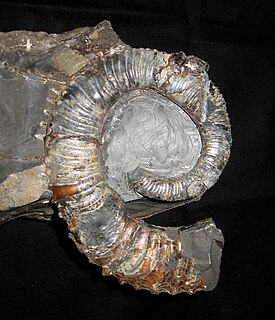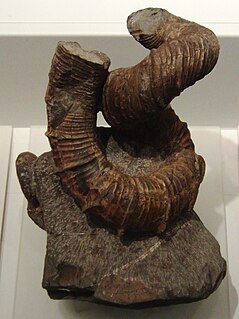
Ancyloceras is an extinct genus of heteromorph ammonites found throughout the world during the Lower Cretaceous, from the Lower Barremian epoch until the genus extinction during the Lower Aptian.
Aspinoceras is an extinct genus of heteromorph ammonites that lived during the Early Cretaceous. The shell small; starts off with a few loosely wound whorls not in contact followed by a short moderately curved shaft ending in a broad hook. Surface covered with mostly fine, close spaced ribs, with periodic larger ribs. In general form it resembles Ancyloceras.
Astiericeras is an ammonite from the Lower Cretaceous, the shell of which is evolute, stout; outer whorl with strong, well spaced, transverse ribs that cross smoothly over the broad venter; early whorls with lateral tubercles. The outer, mature whorl separates from the coil but hooks back quickly, referred to as a heteromorph.
Uhligia is a genus of Lower Cretaceous (Barremian) ancylocerid ammonoid cephalopods initially found in Germany.
Anisoceratidae is an extinct family of heteromorph ammonites which belong to the Ancyloceratina superfamily Turrilitoidea. Members of the family range is from the lower Albian to the upper Turonian. The family is possibly derived from a member of the Hamitidae.

Nipponites is an extinct genus of heteromorph ammonites. The shells of Nipponites form "ox-bow" bends, resulting in some of the most bizarre shapes seen among ammonites.

Bostrychoceras is a genus of heteromorph ammonite from the family Nostoceratidae. Fossils have been found in Late Cretaceous sediments in Europe and North America.

Exiteloceras is an ammonite genus from the Late Cretaceous.

Nostoceras is an extinct genus of ammonites. The etymology of the name Nostoceras comes from "nostos" meaning return and "ceros" meaning horn, named as such by Alpheus Hyatt because it bends back on itself.

Eubostrychoceras is a genus of helically wound, corkscrew form, heteromorph ammonite which lived during the Upper Cretaceous. The genus is included in the ancycleratid family Nostoceratidae.
Bochianites is a straight shelled ammonite which lived from the Upper Jurassic, Tithonian, to the Lower Cretaceous, Hauterivian in what is now Europe, Greenland, Africa, North America and Asia. The shell is long, narrow, moderately expanding; smooth or with weak to strong oblique annular ribs. Sutural elements are short and boxy. The umbilical lobe, which lies between the lateral lobe and dorsal lobe, on either side, is about the same size as the lobule dividing the first lateral saddle.
Curacoites is a genus of ammonites which existed during the early Barremian of what is now Argentina. It was described by Beatriz Aguirre-Urreta and Peter F. Rawson in 2012, and the type species is C. rotundus.
Sabaudiella is a genus of ammonites. It was described by Vasicek and Hoedemaeker in 2003, and the type species is S. sabaudianus, which was originally assigned to the genus Ancyloceras by Pictet and de Loriol in 1858. A new species, S. riverorum, which existed during the early Barremian of what is now Argentina, was described by Beatriz Aguirre-Urreta and Peter F. Rawson in 2012.

Macroscaphites is an extinct cephalopod genus included in the Ammonoidea that lived during the Barremian and Aptian stages of the Early Cretaceous. Its fossils have been found throughout most of Europe and North Africa.

Barremitinae is a subfamily belonging to the Ammonoidea subclass. Whorl section in this group ranges from more or less circular through rectangular to oxyconic. Ribbing, if present, is weak. Suture is relatively simple, without markedly retracted suspensive lobe.

Heinzia is an extinct ammonoid cephalopod genus belonging to the family Pulchelliidae. They lived during the Cretaceous, in the Barremian age.
Stenorhynchosaurus is an extinct genus of pliosaurid plesiosaurs which lived in South America during the Early Cretaceous. The type species and only known is Stenorhynchosaurus munozi.

Leyvachelys is an extinct genus of turtles in the family Sandownidae from the Early Cretaceous of the present-day Altiplano Cundiboyacense, Eastern Ranges, Colombian Andes. The genus is known only from its type species, Leyvachelys cipadi, described in 2015 by Colombian paleontologist Edwin Cadena. Fossils of Leyvachelys have been found in the fossiliferous Paja Formation, close to Villa de Leyva, Boyacá, after which the genus is named. The holotype specimen is the oldest and most complete sandownid turtle found to date.
Antarcticoceras is a genus of crioconic ammonites in the family Shasticrioceratidae. It lived during the Early Cretaceous Period. Antarcticioceras fossils can be found in the Cretaceous rocks of Antarctica and South America.









